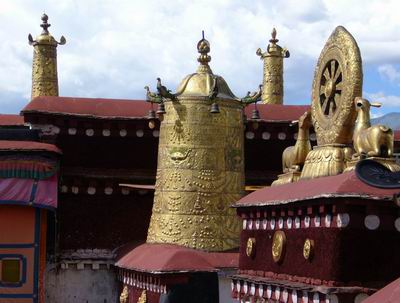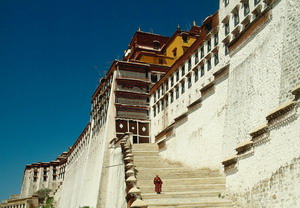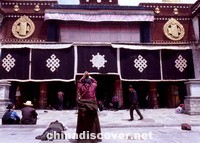Tibet

-
Province:Tibet (Chinese: 西藏, Pinyin: Xī Zàng)
-
Population :2,840,000
-
Area :1,228,400 square km (474,300 square mile)
-
Overview:With an average elevation of 4,900 metres (16,000 ft), Tibet has long been a favored destination for tourists from around the world.
Tibet Weather
Tibet has a highland climate, with lower temperature and less precipitation than most parts of China. It has thin air, long hours of sunshine and intense solar radiation. There is great difference in climate between the north -- where the Northern Tibet Plateau has a mean annual temperature of -2℃. and is covered with snow half of the year -- and the south where the Southern Tibet Valleys are much more temperate and humid. Lhasa, for example, has a mean annual temperature of approximately 8℃.
The topography and geographical location of Tibet and its great altitude create peculiar climate of Tibet. Generally speaking, the climate is rather harsh, with thin air, insufficient oxygen, intense sunlight and ultraviolet radiation. However, it is not impossible to visit this holy land. In summer it tends to be very cool, though in winter it is not as cold as people imagine due to the intense sunlight. Temperature extremes occur during both day and night due to the thin atmosphere being unable to either absorb or retain heat.
Sun radiation is extremely strong in Tibet. The sunlight in Lhasa is so intense that the city is called Sunlight City. The thin air can neither block off nor retain heat so that the temperature extremes can be met in daytime and the same night respectively in Tibet. However it is not impossible to visit the holy snow land. May, June and September are the tourism season in east Tibet.
With its flat land and mild weather, Lhasa is free of both frigid winters and unbearably hot summers, having an annual average daily temperature of 8 degrees C (43 degrees F). It enjoys 3,000 hours of sunlight annually, so much more than most other cities, it is sometimes called the "sunlit city." Lhasa has an annual precipitation of 500 mm. It rains mainly in July, August and September. The rainy seasons in the summer and fall are widely regarded the "best" seasons of the year, when it rains mostly at night, and is sunny in the daytime.
Most annual rainfall comes in the rainy season that starts from June to September. Usually it rains at night in Lhasa, Shigatse and Chamdo area. The rainfall may block roads and make travel difficult but the scenery at the time will be the best.
So generaly speaking, the best time to travel Tibet is between April and October, and peak season is from May to September. The best months are May, June, September or October as July and August are rainy months. Those who travel in their own car or on foot should avoid the rainy season especialy when entering Tibet along the Sichuan-Tibet Highway, and the sections between Lhasa and Nyingchi and between Lhasa and Ngari. There will be mudslides, cave-ins and mire on certain sections of the road, blocking the passage of vehicles. However, if you are only planning several days in and around Lhasa and getting there by air. There will be no problem for you to travel at any time from April to October.
Here is some more specific information in different areas:
Lhasa /Shigatse /Lhatse /Tingri /Nyalan:
Along the Friendship highway is basically in good conditions year around. But from December to February, the thawed road could make some trouble. Try to avoid August - landslide could happen in the rainy season.
Mt. Everest Area:
Early May and early October are the best time to visit Mt. Everest. Due to the clear weather, you have great chance to see Mt. Everest$$s true face (if you are lucky). From December to February, you$$d better not to go to this area because it is too cold - except you are real Great Adventure People.
Ali (Mt.Kailash):
Even without climate restrictions, this area is already inhospitable. Big rain and snow could make the journey worse. However, for those determined tourists, the appropriate time is May, June, July, September and October.
Eastern Tibet: Do not go to this area in July or August (the rainy season) because the rain could ruin the road, and make terrible landslides. In winter, the road could be frozen.
Northern Tibet:
With the average altitude of 4,500m, this area offers very limited time for tourists. Summer (July to August) is the prime time to enjoy the great plain in northern Tibet.
Lhasa Weather Records and Averages
| Month | Avg. High | Avg. Low | Avg. Precip |
|---|---|---|---|
| January | 7.0° C | -10.0° C | 0.00 cm |
| February | 9.0° C | -7.0° C | 0.00 cm |
| March | 12.0° C | -3.0° C | 0.25 cm |
| April | 16.0° C | 1.0° C | 0.51 cm |
| May | 19.0° C | 5.0° C | 2.79 cm |
| June | 23.0° C | 9.0° C | 7.37 cm |
| July | 22.0° C | 10.0° C | 11.94 cm |
| August | 21.0° C | 9.0° C | 12.19 cm |
| September | 20.0° C | 8.0° C | 5.84 cm |
| October | 16.0° C | 1.0° C | 1.02 cm |
| November | 11.0° C | -5.0° C | 0.25 cm |
| December | 8.0° C | -9.0° C | 0.00 cm |



